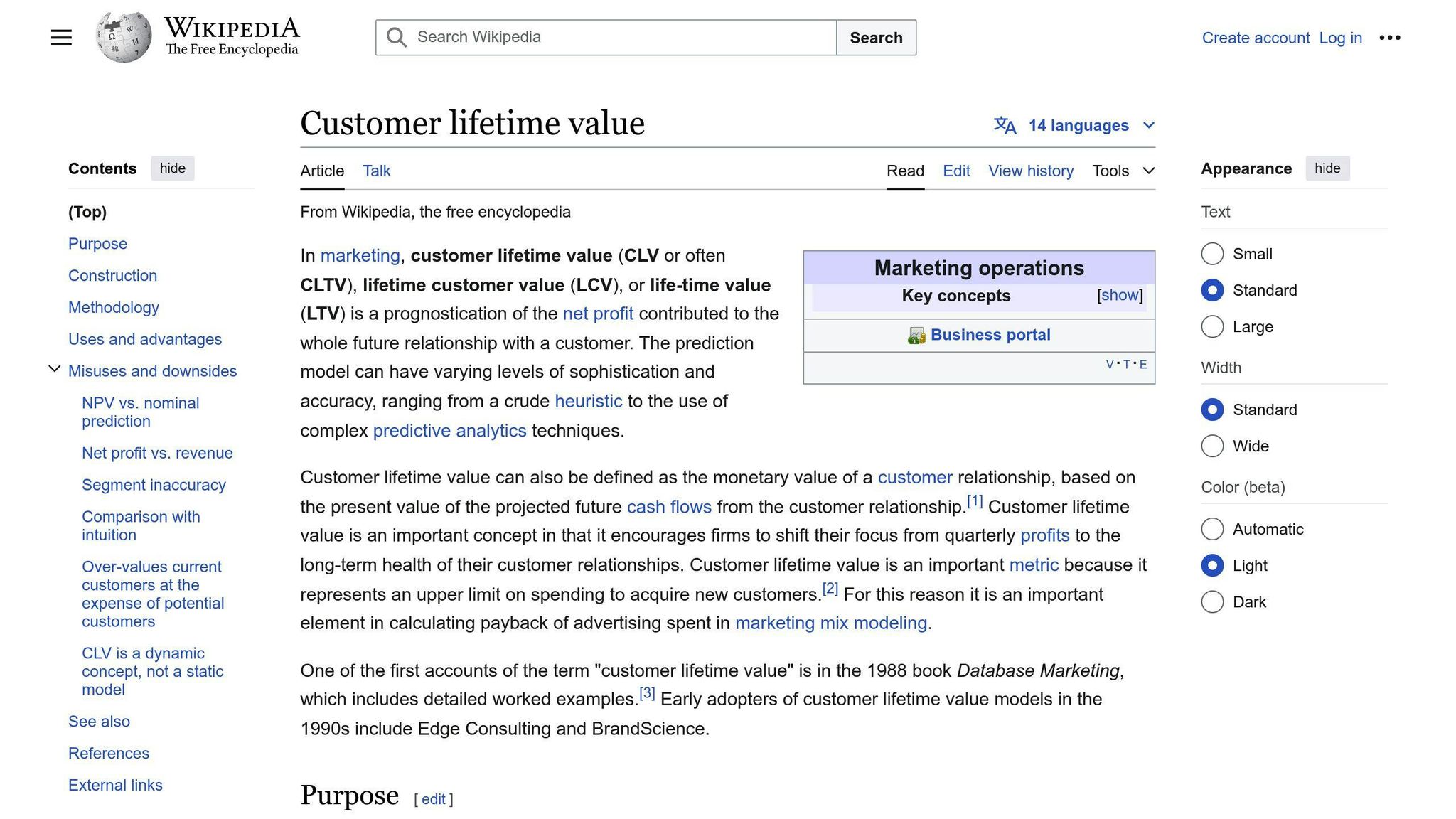Customer Lifetime Value (CLV) is a crucial metric that measures the total revenue a customer generates for an ecommerce business over their entire relationship. Focusing on CLV helps online stores:
- Identify high-value customers to retain
- Offer personalized experiences and promotions
- Develop effective loyalty programs
- Optimize marketing strategies for sustainable growth
To calculate CLV, consider:
| Factor | Description |
|---|---|
| Average Order Value | Average amount spent per transaction |
| Purchase Frequency | Number of purchases in a time period |
| Customer Lifespan | Duration a customer remains active |
Additional factors like revenue from referrals, upsells, and repeat purchases provide a more comprehensive CLV calculation.
By understanding CLV, ecommerce businesses can shift from short-term gains to building long-term customer relationships, driving profitability and growth in a competitive market.
Related video from YouTube
What is Customer Lifetime Value?

Customer Lifetime Value (CLV) measures the total value a customer brings to a business over their lifetime. It's a key performance indicator (KPI) that helps ecommerce businesses understand the long-term potential of their customers and make data-driven decisions to drive growth and profitability.
Past vs. Future Customer Value
There are two types of CLV models:
| Model | Description |
|---|---|
| Historic CLV | Analyzes a customer's past spending habits to estimate their total value. |
| Predictive CLV | Uses historical data to forecast future spending. |
Historic CLV provides a snapshot of a customer's past behavior, while predictive CLV provides a more accurate estimate of a customer's lifetime value and helps businesses identify opportunities to increase revenue and loyalty.
CLV's Link to Revenue and Growth
CLV is directly connected to a company's revenue and growth. By understanding the lifetime value of their customers, businesses can:
- Identify opportunities to increase revenue through targeted marketing, loyalty programs, and personalized experiences.
- Allocate resources more efficiently, focusing on high-value customers and reducing churn.
- Drive sustainable growth and profitability in a competitive market.
Unlike metrics like Net Promoter Score (NPS) and Customer Satisfaction (CSAT), CLV provides a clear picture of a customer's financial value to the business.
Why CLV is Important for Online Stores
Customer Lifetime Value (CLV) is a vital metric for ecommerce businesses, offering several strategic advantages that can drive growth, revenue, and profitability. By focusing on CLV, online stores can:
- Retain customers cost-effectively: Understanding the lifetime value of customers helps businesses allocate resources more efficiently, reducing customer acquisition costs and increasing retention rates.
- Detect churn early: CLV analysis can identify at-risk customers, enabling targeted interventions to prevent churn and maintain revenue streams.
- Replicate success patterns: Analyzing the behavior and characteristics of high-value customers can inform marketing strategies, helping businesses replicate their success and attract more profitable customers.
By prioritizing CLV, online stores can shift their focus from short-term gains to building long-term relationships with their most valuable customers. This approach can lead to:
| Benefits | Description |
|---|---|
| Increased revenue | By targeting high-value customers and reducing churn |
| Improved customer satisfaction | Through personalized experiences and targeted promotions |
| Sustainable growth | By focusing on long-term relationships and loyalty |
By understanding the lifetime value of their customers, online stores can make data-driven decisions to drive growth and profitability in a competitive market.
Calculating Customer Lifetime Value
Calculating Customer Lifetime Value (CLV) is a crucial step in understanding the long-term potential of your customers. By accurately calculating CLV, you can identify opportunities to increase revenue, improve customer satisfaction, and optimize your marketing strategies.
The Basic CLV Formula
The fundamental CLV calculation formula is:
CLV = (Average Order Value x Purchase Frequency) x Average Customer Lifespan
Here's what each part of the formula means:
| Term | Description |
|---|---|
| Average Order Value (AOV) | The average amount spent by a customer in a single transaction. |
| Purchase Frequency | The average number of purchases made by a customer within a specific time period. |
| Average Customer Lifespan | The average amount of time a customer remains a customer. |
This formula provides a basic understanding of CLV, but it's essential to include additional data points to get a more accurate calculation.
Including Customer Journey Data
To get a more comprehensive understanding of CLV, you should include revenue from each touchpoint in the customer journey. This includes:
- Revenue from repeat purchases: The revenue generated from customers making repeat purchases.
- Revenue from referrals: The revenue generated from customer referrals.
- Revenue from upsells and cross-sells: The revenue generated from selling additional products or services to customers.
By including these data points, you can get a more accurate calculation of CLV and identify opportunities to increase revenue and improve customer satisfaction.
Remember, calculating CLV is not a one-time task. It's essential to regularly review and update your calculations to ensure you're getting an accurate picture of your customers' value.
sbb-itb-d1a6c90
Improving CLV for Online Store Growth
Improving Customer Lifetime Value (CLV) is crucial for the growth and success of online stores. By focusing on customer experience, loyalty programs, and omnichannel support, you can increase revenue, improve customer satisfaction, and reduce churn.
Effective Loyalty Programs
A well-designed loyalty program can significantly impact CLV. To create an effective loyalty program, consider the following components:
| Component | Description |
|---|---|
| Reward structure | Offer rewards that are relevant and appealing to your customers, such as discounts, free shipping, or exclusive access to new products. |
| Personalization | Tailor your loyalty program to individual customers based on their purchase history, preferences, and behavior. |
| Multi-channel integration | Ensure that your loyalty program is accessible across all touchpoints, including your website, social media, and physical stores. |
By incorporating these components, you can create a loyalty program that drives repeat business, increases customer loyalty, and ultimately boosts CLV.
Optimizing Customer Experience
Customer experience plays a critical role in improving CLV. To optimize customer experience, focus on the following areas:
| Area | Description |
|---|---|
| Streamlined checkout process | Make it easy and convenient for customers to complete their purchases. |
| Personalized communication | Tailor your communication to individual customers based on their preferences and behavior. |
| Omnichannel support | Provide seamless support across all touchpoints, including phone, email, chat, and social media. |
By optimizing customer experience, you can increase customer satisfaction, reduce churn, and improve CLV.
By implementing these strategies, you can improve CLV, increase revenue, and drive growth for your online store. Remember to regularly review and update your calculations to ensure you're getting an accurate picture of your customers' value.
Advanced CLV Strategies for Online Stores
Advanced Customer Lifetime Value (CLV) strategies can help ecommerce businesses better understand their customers' value and engage with them more effectively. In this section, we'll explore two advanced strategies: using data to predict CLV and personalized marketing for CLV.
Using Data to Predict CLV
Predictive analytics can help ecommerce businesses forecast customer lifetime value more accurately. By analyzing customer behavior, purchase history, and demographic data, businesses can identify patterns and trends that indicate high-value customers. This information can be used to create targeted marketing campaigns, offer personalized promotions, and improve customer retention.
For example, a fashion ecommerce store can use predictive analytics to identify customers who are likely to make repeat purchases based on their purchase history and browsing behavior. The store can then offer these customers personalized promotions and loyalty rewards to encourage repeat business and increase their lifetime value.
Personalized Marketing for CLV
Personalized marketing is a key strategy for increasing customer lifetime value in ecommerce. By segmenting customers based on their CLV, businesses can create targeted marketing campaigns that resonate with high-value customers. This can include offering personalized product recommendations, exclusive promotions, and loyalty rewards that are tailored to individual customers' preferences and behavior.
Here are some ways to implement personalized marketing for CLV:
| Strategy | Description |
|---|---|
| Personalized product recommendations | Offer customers product recommendations based on their purchase history and browsing behavior. |
| Exclusive promotions | Offer high-value customers exclusive promotions and discounts to encourage repeat business. |
| Loyalty rewards | Offer loyalty rewards to high-value customers to encourage repeat business and increase their lifetime value. |
By using data to predict CLV and personalized marketing strategies, ecommerce businesses can increase customer lifetime value, improve customer retention, and drive revenue growth.
Challenges in Calculating CLV
Calculating Customer Lifetime Value (CLV) can be a complex task, and ecommerce businesses may face several challenges when trying to accurately calculate this metric.
Including Customer Churn
One of the most significant challenges in calculating CLV is accounting for customer churn rates. Customer churn refers to the rate at which customers stop doing business with a company. If a business does not account for churn rates, it may overestimate the lifetime value of its customers.
For example, if a customer is expected to make repeat purchases over a five-year period, but the business has a high churn rate, the customer may not remain a customer for the entire five years. Therefore, it is essential to include churn rates in CLV calculations to get a more accurate picture of customer value.
Dealing with Data Issues
Another challenge in calculating CLV is dealing with data issues. Collecting and analyzing customer data can be a complex task, and businesses may encounter several data-related problems.
Common Data Issues:
| Issue | Description |
|---|---|
| Incomplete or inaccurate customer data | Missing or incorrect customer information can lead to inaccurate CLV calculations. |
| Difficulty in tracking customer behavior | Tracking customer behavior across multiple channels can be challenging, making it difficult to calculate CLV accurately. |
| Insufficient data | Limited customer data can make it difficult to make accurate predictions about customer behavior. |
To overcome these challenges, businesses can implement data management strategies, such as data cleansing and data integration, to ensure that customer data is accurate and complete. Additionally, businesses can use data analytics tools to track customer behavior and make predictions about future behavior.
By addressing these challenges, ecommerce businesses can ensure that they accurately calculate CLV and make informed decisions about customer retention and acquisition strategies.
Using CLV for Online Store Success
To achieve long-term growth and profitability in ecommerce, it's crucial to understand and utilize Customer Lifetime Value (CLV) effectively. By knowing the value of each customer, online stores can make informed decisions about customer retention and acquisition strategies.
Here's a recap of the key takeaways from this guide:
Strategies for Online Store Success
To leverage CLV for online store success, ecommerce businesses can implement the following practical steps:
| Strategy | Description |
|---|---|
| Develop effective loyalty programs | Retain customers and encourage repeat purchases |
| Optimize customer experience | Provide personalized marketing, excellent customer service, and streamlined processes |
| Use data analytics | Predict CLV and identify opportunities for growth |
| Account for customer churn rates and data issues | Ensure accurate CLV calculations |
| Focus on building long-term relationships | Increase customer lifetime value |
By following these steps, online stores can unlock the full potential of CLV and drive sustained growth and profitability. Remember, CLV is a fundamental metric in ecommerce success, and understanding its importance can make all the difference in your business's bottom line.
FAQs
What does LTV mean in ecommerce?
LTV, or customer lifetime value, is a measure of how much revenue a customer is expected to generate for your business over their lifetime. It helps you understand how much a customer is worth to your business.
What is LTV in ecommerce?
LTV is the total revenue a customer is expected to generate for your business. It takes into account how often they make purchases, how much they spend, and how long they remain a customer. By understanding LTV, you can identify opportunities to increase revenue and improve customer relationships.
| Term | Description |
|---|---|
| Purchase Frequency | How often a customer makes a purchase |
| Average Order Value | The average amount spent by a customer in a single transaction |
| Customer Lifespan | The average amount of time a customer remains a customer |
By considering these factors, you can calculate LTV and make informed decisions about customer retention and acquisition strategies.


